
A column or pillar in architecture and structural engineering is a structural element that transmits, through compression, the weight of the structure above to other structural elements below. In other words, a column is a compression member. The term column applies especially to a large round support with a capital and a base or pedestal which is made of stone, or appearing to be so. A small wooden or metal support is typically called a post, and supports with a rectangular or other non-round section are usually called piers. For the purpose of wind or earthquake engineering, columns may be designed to resist lateral forces. Other compression members are often termed "columns" because of the similar stress conditions. Columns are frequently used to support beams or arches on which the upper parts of walls or ceilings rest. In architecture, "column" refers to such a structural element that also has certain proportional and decorative features. A column might also be a decorative element not needed for structural purposes; many columns are "engaged", that is to say form part of a wall.

An order in architecture is a certain assemblage of parts subject to uniform established proportions, regulated by the office that each part has to perform.
Coming down to the present from Ancient Greek and Ancient Roman civilization, the architectural orders are the styles of classical architecture, each distinguished by its proportions and characteristic profiles and details, and most readily recognizable by the type of column employed. The three orders of architecture—the Doric, Ionic, and Corinthian—originated in Greece. To these the Romans added, in practice if not in name, the Tuscan, which they made simpler than Doric, and the Composite, which was more ornamental than the Corinthian. The architectural order of a classical building is akin to the mode or key of classical music; the grammar or rhetoric of a written composition. It is established by certain modules like the intervals of music, and it raises certain expectations in an audience attuned to its language.

The Corinthian order is the last developed of the three principal classical orders of ancient Greek and Roman architecture. The other two are the Doric order which was the earliest, followed by the Ionic order. When classical architecture was revived during the Renaissance, two more orders were added to the canon, the Tuscan order and the Composite order. The Corinthian, with its offshoot the Composite, is the most ornate of the orders. This architectural style is characterized by slender fluted columns and elaborate capitals decorated with acanthus leaves and scrolls. There are many variations.

The Ionic order forms one of the three classical orders of classical architecture, the other two canonic orders being the Doric and the Corinthian. There are two lesser orders: the Tuscan, and the rich variant of Corinthian called the composite order, both added by 16th-century Italian architectural writers, based on Roman practice. Of the three canonic orders, the Ionic order has the narrowest columns.
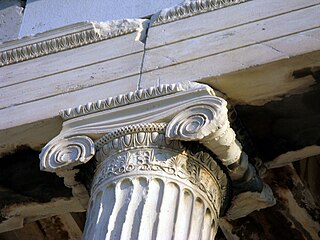
In architecture the capital or chapiter forms the topmost member of a column. It mediates between the column and the load thrusting down upon it, broadening the area of the column's supporting surface. The capital, projecting on each side as it rises to support the abacus, joins the usually square abacus and the usually circular shaft of the column. The capital may be convex, as in the Doric order; concave, as in the inverted bell of the Corinthian order; or scrolling out, as in the Ionic order. These form the three principal types on which all capitals in the classical tradition are based. The Composite order, established in the 16th century on a hint from the Arch of Titus, adds Ionic volutes to Corinthian acanthus leaves.
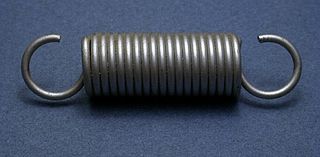
A coil spring, also known as a helical spring, is a mechanical device which is typically used to store energy and subsequently release it, to absorb shock, or to maintain a force between contacting surfaces. They are made of an elastic material formed into the shape of a helix which returns to its natural length when unloaded.
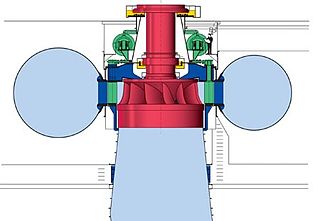
The Francis turbine is a type of water turbine that was developed by James B. Francis in Lowell, Massachusetts. It is an inward-flow reaction turbine that combines radial and axial flow concepts.
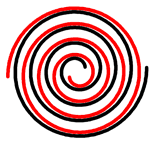
A scroll compressor is a device for compressing air or refrigerant. It is used in air conditioning equipment, as an automobile supercharger and as a vacuum pump. Many residential central heat pump and air conditioning systems and a few automotive air conditioning systems employ a scroll compressor instead of the more traditional rotary, reciprocating, and wobble-plate compressors.

The aperture is an opening in certain kinds of mollusc shells: it is the main opening of the shell, where the head-foot part of the body of the animal emerges for locomotion, feeding, etc.

A krater or crater was a large vase in Ancient Greece, particularly used for watering down wine.
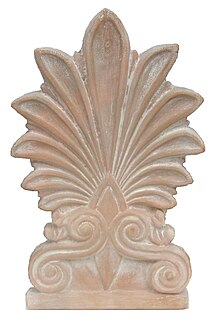
The palmette is a motif in decorative art which, in its most characteristic expression, resembles the fan-shaped leaves of a palm tree. It has a far-reaching history, originating in ancient Egypt with a subsequent development through the art of most of Eurasia, often in forms that bear relatively little resemblance to the original. In ancient Greek and ancient Roman uses it is also known as the anthemion. It is found in most artistic media, but especially as an architectural ornament, whether carved or painted, and painted on ceramics. It is very often a component of the design of a frieze or border. The complex evolution of the palmette was first traced by Alois Riegl in his Stilfragen of 1893. The half-palmette, bisected vertically, is also a very common motif, found in many mutated and vestigial forms, and especially important in the development of plant-based scroll ornament.
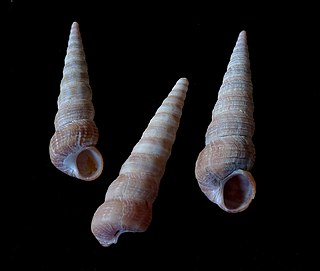
A spire is a part of the coiled shell of molluscs. The spire consists of all of the whorls except for the body whorl. Each spire whorl represents a rotation of 360°. A spire is part of the shell of a snail, a gastropod mollusc, a gastropod shell, and also the whorls of the shell in ammonites, which are fossil shelled cephalopods.

The composite order is a mixed order, combining the volutes of the Ionic order capital with the acanthus leaves of the Corinthian order. In many versions the composite order volutes are larger, however, and there is generally some ornament placed centrally between the volutes. The column of the composite order is typically ten diameters high, though as with all the orders these details may be adjusted by the architect for particular buildings. The Composite order is essentially treated as Corinthian except for the capital, with no consistent differences to that above or below the capital. The composite order is not found in ancient Greek architecture and until the Renaissance was not ranked as a separate order. Instead it was considered as an imperial Roman form of the Corinthian order. Though the Arch of Titus, in the forum in Rome and built in 82 AD, is sometimes cited as the first prominent surviving example of a composite order, the order was probably invented "a little before Augustus's reign, and certainly well-developed before his death, the very time when the Roman version of Corinthian was being established."

The scroll in art is an element of ornament and graphic design featuring spirals and rolling incomplete circle motifs, some of which resemble the edge-on view of a book or document in scroll form, though many types are plant-scrolls, which loosely represent plant forms such as vines, with leaves or flowers attached. Scrollwork is a term for some forms of decoration dominated by spiralling scrolls, today used in popular language for two-dimensional decorative flourishes and arabesques of all kinds, especially those with circular or spiralling shapes.

Cymatium molding appears at the top of the cornice in the classical order, and made of the s-shaped cyma molding, combining a concave cavetto with a convex ovolo. It is characteristic of Ionic columns and can appear as part of the entablature, the epistylium, and the capital. Often decorated with a palmette or egg-and-dart ornament on the surface of the molding.

The scroll-type supercharger is a positive displacement orbiting-spiral supercharger. It is a compromise between the more rugged rotating lobe, and the more efficient sliding vane type superchargers, and is considered to offer the highest potential in regard to efficiency, noise and pressure fluctuation.
Quinnia ionica is a species of sea snail, a marine gastropod mollusk in the family Seguenziidae.



















